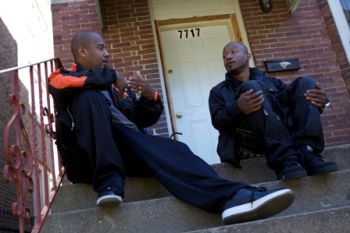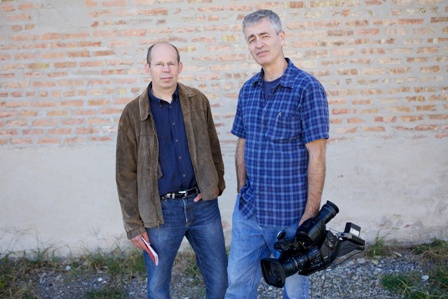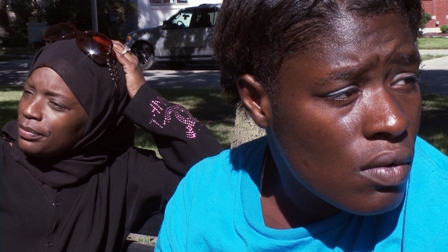Violence in the Streets: On making The Interrupters | reviews, news & interviews
Violence in the Streets: On making The Interrupters
Violence in the Streets: On making The Interrupters
A documentary about gang violence chokes in the Chicago projects
Twenty-four years ago, I found myself hanging out virtually every day in the Henry Horner Homes, a Chicago housing project on the city's hardscrabble West Side. I had begun to immerse myself in the lives of two young brothers, Lafeyette and Pharoah Rivers, in an effort to understand what it means to be growing up poor in the world's wealthiest nation. Mother Teresa had visited this neighbourhood just a few years earlier, and what so struck her was not the poverty of the pocketbook - she had certainly seen worse in India - but rather what she called “the poverty of the spirit”. Indeed, it was a dispiriting place - especially the shootings which had become such a regular occurrence that the kids knew the drill: crouch in their windowless hallway of their apartment until the gunfire stopped - and count to make sure everyone was there.
The first time I met Lafeyette, the older of the two brothers - he was 12 years old - he told me about a teenaged boy who had been shot in a gang war, and died on the stairwell just outside his apartment. I was new to the community, and he must have sensed my disbelief because he then physically took me by the arm to show me the fresh bloodstains on the stairs. It became clear to me from that first meeting with Lafeyette that so much of what defined his life and his community was the silence that surrounded them. And so I suspect in many ways, my books, my magazine writing, my radio pieces, and now my film (The Interrupters, a collaboration with long-time friend and Hoop Dreams director, Steve James) have been an effort to bear witness, to listen to and tell stories that otherwise would go unnoticed or untold.
Watch the trailer to The Interrupters
I spent two years with Lafeyette and Pharoah, mostly just hanging out, and I suppose the facile way to describe my reporting style is as the proverbial fly on the wall, but I learned early on that if I just hung back I would miss much, especially the ability to empathise with those I was writing about. So I was constantly engaging the people in the community: the kids, the adults, the police, the city workers, the teachers. Anyone who touched the lives of those living there. I asked questions, questions I had no business asking, and poked and prodded and challenged. Even got into heated discussions. But how else can one fully understand why someone makes the choices they do?
 When I had finished my reporting and had begun writing my book, There Are No Children Here, I struggled with what to do with one piece of information: during my time there, I came to learn that two or three nights a week the boys' mother, LaJoe, would stay out all night playing cards in an apartment at the other end of the housing project. I learned about her forays from Lafeyette and Pharoah because numerous mornings they would call me and tell me their mother wasn't there, that they didn't have anything to eat for breakfast or didn't have clean clothes for school. Often, I'd hop in my car, and bring with me some cereal and milk, and after a while I travelled with fresh socks and underwear that I could give them if they needed it. Needless to say, I got angrier and angrier at LaJoe. One evening I went for a walk with a friend of mine, and I told her about my dilemma: how to be honest to what I saw without letting my agitation come through. My friend began to lecture me. She was the mother of three children (I was single at the time), and she explained to me how tough it was to be a mom, even in the best of circumstances, let alone a single mom, let alone a single mom growing up in such a dispiriting place and in such profound poverty. LaJoe, she explained, needed a respite, and this was the only way she could find it. She wasn't trying to justify Lajoe's activities, just trying to get me to understand it. It was my first real lesson in finding empathy which in the end is at the heart of any good story.
When I had finished my reporting and had begun writing my book, There Are No Children Here, I struggled with what to do with one piece of information: during my time there, I came to learn that two or three nights a week the boys' mother, LaJoe, would stay out all night playing cards in an apartment at the other end of the housing project. I learned about her forays from Lafeyette and Pharoah because numerous mornings they would call me and tell me their mother wasn't there, that they didn't have anything to eat for breakfast or didn't have clean clothes for school. Often, I'd hop in my car, and bring with me some cereal and milk, and after a while I travelled with fresh socks and underwear that I could give them if they needed it. Needless to say, I got angrier and angrier at LaJoe. One evening I went for a walk with a friend of mine, and I told her about my dilemma: how to be honest to what I saw without letting my agitation come through. My friend began to lecture me. She was the mother of three children (I was single at the time), and she explained to me how tough it was to be a mom, even in the best of circumstances, let alone a single mom, let alone a single mom growing up in such a dispiriting place and in such profound poverty. LaJoe, she explained, needed a respite, and this was the only way she could find it. She wasn't trying to justify Lajoe's activities, just trying to get me to understand it. It was my first real lesson in finding empathy which in the end is at the heart of any good story.
 People have often asked: wasn't it difficult - even dangerous - being a white guy in this all African-American community? I can't help but smile. In many ways, it afforded me a level of protection. I stood out, so people wanted to know what I was doing there, and if they didn't ask me directly they asked others who knew. One afternoon, I was walking behind the family's building with LaJoe, and about 20 feet in front of us was one of the gang leaders and a young gang member. At one point, I saw the young gang member lean over and whisper something to his boss. The gang leader looked over his shoulder at LaJoe and me, and laughed. "That's just Alex," he told his protégé. And they walked on.
People have often asked: wasn't it difficult - even dangerous - being a white guy in this all African-American community? I can't help but smile. In many ways, it afforded me a level of protection. I stood out, so people wanted to know what I was doing there, and if they didn't ask me directly they asked others who knew. One afternoon, I was walking behind the family's building with LaJoe, and about 20 feet in front of us was one of the gang leaders and a young gang member. At one point, I saw the young gang member lean over and whisper something to his boss. The gang leader looked over his shoulder at LaJoe and me, and laughed. "That's just Alex," he told his protégé. And they walked on.
I suppose in the end, so much of non-fiction writing and film-making is about being an outsider, about going places we otherwise might not spend time, meeting people whom we otherwise might not have reason to befriend. It's what's both exhilarating and intimidating about non-fiction storytelling. In the end, you hope you're able to distil the journey you've had in a way that feels absolutely honest to what you've seen and heard - and in a way that lets readers or viewers experience it as if they were taking that same journey themselves. The toughest part? Being willing to challenge your assumptions and preconceptions at every bend and corner. And placing yourself - and ultimately your readers - in the shoes of your subjects, to get them to look at the world through their eyes.
 In The Interrupters, Steve and I filmed 17-year-old Li'l Mikey as he got out a youth prison where he'd just completed a three-year sentence for armed robbery of a barber shop. Li'l Mikey's reputation preceded him. When he was on the street, we learned, he was not someone to mess with. You meet a Li'l Mikey, and you think you know his story, the shape of his narrative. But Li'l Mikey knocked us off balance. In one remarkable scene, Li'l Mikey returns to the barber shop to apologise for what he did. He's stoic and nervous and clearly has rehearsed his lines. And one of the barber shop patrons who was there the day of the robbery doesn't let him off easily. But you come to realise, Li'l Mikey is not necessarily looking for forgiveness, he's looking for a way to forgive himself. He's looking to take ownership of what he had done. Li'l Mikey is now working as an outreach worker for an anti-violence organisation in the city.
In The Interrupters, Steve and I filmed 17-year-old Li'l Mikey as he got out a youth prison where he'd just completed a three-year sentence for armed robbery of a barber shop. Li'l Mikey's reputation preceded him. When he was on the street, we learned, he was not someone to mess with. You meet a Li'l Mikey, and you think you know his story, the shape of his narrative. But Li'l Mikey knocked us off balance. In one remarkable scene, Li'l Mikey returns to the barber shop to apologise for what he did. He's stoic and nervous and clearly has rehearsed his lines. And one of the barber shop patrons who was there the day of the robbery doesn't let him off easily. But you come to realise, Li'l Mikey is not necessarily looking for forgiveness, he's looking for a way to forgive himself. He's looking to take ownership of what he had done. Li'l Mikey is now working as an outreach worker for an anti-violence organisation in the city.
It's what so exhilarating about telling stories of real people: as a storyteller, you're both limited and liberated by the often complicated, surprising trajectory of people's lives, and in the end, without I hope sounding like too much of a romantic, often come away inspired by how those encumbered by circumstance - whether it be class or race or something else - manage to remain erect under the weight of forces so strong and wretched they undoubtedly would make most of us stumble and fall. Their own personal journeys, as difficult and tumultuous as they might be, in the end, strengthens their resolve, not weakens it. After writing There Are No Children Here, I came away inspired by Lafeyette and Pharoah. After filming The Interrupters I came away inspired by the likes of Li'l Mikey. Someone once asked me why I'm always drawn to such dark places, such dark stories, but in those on the bottom clawing and scratching for a decent, dignified, honourable life I find reason for hope, I find an abundance of light.
- The Interrupters is released on Friday
 Find Alex Kotlowitz's There Are No Children Here on Amazon
Find Alex Kotlowitz's There Are No Children Here on Amazon
Explore topics
Share this article
more Film
 Nezouh review - seeking magic in a war
A movie that looks on the dreamier side of Syrian strife
Nezouh review - seeking magic in a war
A movie that looks on the dreamier side of Syrian strife
 Blu-ray: The Dreamers
Bertolucci revisits May '68 via intoxicated, transgressive sex, lit up by the debuting Eva Green
Blu-ray: The Dreamers
Bertolucci revisits May '68 via intoxicated, transgressive sex, lit up by the debuting Eva Green
 theartsdesk Q&A: Marco Bellocchio - the last maestro
Italian cinema's vigorous grand old man discusses Kidnapped, conversion, anarchy and faith in cinema
theartsdesk Q&A: Marco Bellocchio - the last maestro
Italian cinema's vigorous grand old man discusses Kidnapped, conversion, anarchy and faith in cinema
 I.S.S. review - sci-fi with a sting in the tail
The imperilled space station isn't the worst place to be
I.S.S. review - sci-fi with a sting in the tail
The imperilled space station isn't the worst place to be
 That They May Face The Rising Sun review - lyrical adaptation of John McGahern's novel
Pat Collins extracts the magic of country life in the west of Ireland in his third feature film
That They May Face The Rising Sun review - lyrical adaptation of John McGahern's novel
Pat Collins extracts the magic of country life in the west of Ireland in his third feature film
 Stephen review - a breathtakingly good first feature by a multi-media artist
Melanie Manchot's debut is strikingly intelligent and compelling
Stephen review - a breathtakingly good first feature by a multi-media artist
Melanie Manchot's debut is strikingly intelligent and compelling
 DVD/Blu-Ray: Priscilla
The disc extras smartly contextualise Sofia Coppola's eighth feature
DVD/Blu-Ray: Priscilla
The disc extras smartly contextualise Sofia Coppola's eighth feature
 Fantastic Machine review - photography's story from one camera to 45 billion
Love it or hate it, the photographic image has ensnared us all
Fantastic Machine review - photography's story from one camera to 45 billion
Love it or hate it, the photographic image has ensnared us all
 All You Need Is Death review - a future folk horror classic
Irish folkies seek a cursed ancient song in Paul Duane's impressive fiction debut
All You Need Is Death review - a future folk horror classic
Irish folkies seek a cursed ancient song in Paul Duane's impressive fiction debut
 If Only I Could Hibernate review - kids in grinding poverty in Ulaanbaatar
Mongolian director Zoljargal Purevdash's compelling debut
If Only I Could Hibernate review - kids in grinding poverty in Ulaanbaatar
Mongolian director Zoljargal Purevdash's compelling debut
 The Book of Clarence review - larky jaunt through biblical epic territory
LaKeith Stanfield is impressively watchable as the Messiah's near-neighbour
The Book of Clarence review - larky jaunt through biblical epic territory
LaKeith Stanfield is impressively watchable as the Messiah's near-neighbour
 Back to Black review - rock biopic with a loving but soft touch
Marisa Abela evokes the genius of Amy Winehouse, with a few warts minimised
Back to Black review - rock biopic with a loving but soft touch
Marisa Abela evokes the genius of Amy Winehouse, with a few warts minimised

Add comment